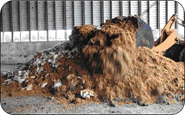| |
On-Farm Management of Dead Sheep and Lambs | |
| |
|
|
| |
|
|
| | It is a simple fact that whenever you raise livestock you have livestock that die. In sheep production proper disposal of dead animals is critical. Lamb producers in addition to the regular reasons for properly dealing with carcasses - sanitation, odour, public perception - must also prevent farm dogs and predators from scavenging carcasses.
Properly disposing of dead sheep and lamb on-farm prevents predators using the carcasses as a food source. The fewer attractions predators have to your lamb operation the better. Preventing access to deads also removes the potential for transmission of the canine Taenia ovis parasite to your sheep. T. ovis is a dog tapeworm that can infect sheep and lambs. Carcasses infected with parasite cysts are condemned at slaughter resulting in lost income for producers, feeders, processors and the industry as a whole.
In Alberta, the “Disposal of Dead Animals Regulation” outlines the legal ways to dispose of dead animals and the requirements that must be followed.
“Setting it Up: Sheep Infrastructure” has a section offering guidelines for disposing of dead sheep/lambs that includes some of the regulations, and more common disposal techniques used by lamb producers.
For access to the module: www.ablamb.ca
Additional producer resources at: www.agriculture.alberta.ca/publications
• Livestock Mortality Management (Disposal) – Agdex 400/29-1 (revised 2011)
• Livestock Mortality Burial Techniques – Agdex 400/29-2 (revised 2011)
An Ontario publication “Disposal Vessels for On-Farm Deadstock” provides disposal vessel options. Disposal vessels are only permitted in Alberta if they follow Alberta regulations; specifically this means the vessel must not be above-ground. The Ontario “Best Management Practices – Deadstock Disposal” is a good resource and the following photos and summaries are adapted from it:
Summary of common on-farm dead stock disposal methods
|  | On-Farm Burial: A carcass may be buried by placing in a larger pit that meets the setback distances in the Disposal of Dead Animals Regulations and covering it with at least 1 m of soil. If done properly this method promotes decomposition while being simple, easy and biosecure. It works best if the animal is buried in well-drained, warm soils. It is difficult to impossible in the winter and may cause groundwater pollution so burial must be (more than one meter) above the seasonal high water level. Burial of more than 2500kg of dead animals in one pit requires approval from the Chief Provincial Veterinarian.
|
 |  | On-Farm Composting: Composting is a procedure where environmental conditions are controlled to allow for the occurrence of aerobic decomposition and the natural breakdown of organic matter. This method works well for sheep operations.
On-farm composting requirements are described in the Disposal of Dead Animals Regulation
|  | |
|  | Incineration: This is a fuel assisted cremation of carcasses which can reduce the carcasses to inert ash. It works well for hog and poultry operations where a larger number of mortalities can be disposed of without having to temporarily hold carcasses. The systems are: costly to set up and to operate; need careful maintenance; can contribute to air pollution; and can be dangerous to operate due to high heat production. In Alberta applicable provisions are found in the Environmental Protection and Enhancement Act as well as the appropriate regulations and codes of practice in the website noted above
|
|  | Disposal Vessels: Disposal vessels are scavenger-proof and leak-proof containers that can be above or underground and that promote dead stock decomposition. The vessels allow for year-round disposal and contribute limited air pollution. Disposal vessels are simple and can be relatively inexpensive to install and operate. Disposal vessels used in Alberta must be buried, not above ground. Details on the requirements for on-farm burial are in the “Disposal of Dead Animals Regulation” and must be followed. |
Author: Susan Hosford, Sheep Industry Specialist, Livestock Research & Extension Branch, Alberta Agriculture & Rural Development
Review: Alberta Animal Health Branch, Animal Health and Assurance Division, Alberta Agriculture & Rural Development
Photos: Ontario “Best Management Practices – Deadstock Disposal” |
|
| |
|
|
| |
This document is maintained by Amrit Matharu.
This information published to the web on October 9, 2014.
Last Reviewed/Revised on October 10, 2014.
|
|